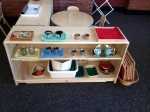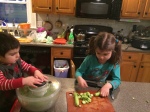 After reading French Kids Eat Everything, Mira reached out to me by email. We shared so many ideas in common! She ended up being one of the ‘test families’ for my new book. I’ve been inspired by her reflections on similarities between the Montessori philosophy and the French approach to food education. Thanks Mira!
After reading French Kids Eat Everything, Mira reached out to me by email. We shared so many ideas in common! She ended up being one of the ‘test families’ for my new book. I’ve been inspired by her reflections on similarities between the Montessori philosophy and the French approach to food education. Thanks Mira!
My family was one of the test families of Karen Le Billon’s cookbook Getting to Yum, and as we’ve worked through the recipes, I’ve been reflecting on the similarities between “French eating” and Montessori education, especially the approach to food. My daughter attended a Montessori preschool, and I’m currently writing a dissertation on the parent communities at two urban public Montessori schools in Connecticut. So while Karen calls these ideas “French”, they’re similar to techniques practiced at 21,000 Montessori schools worldwide.
Here are some of the main ideas I’ve taken from both of Karen’s books and the Montessori schools I’ve observed.
Create a beautiful and peaceful environment for eating
Children at Montessori schools generally eat in their classrooms, allowing them to skip the noisy school cafeteria. But this isn’t scrunched eating at your desk. In many schools I’ve observed, the room is transformed at lunchtime, and students play an integral role in the set-up and clean-up rituals, gaining ownership over their meals. I’ve watched a preschool class of boys spend half an hour setting the table for their classmates, figuring out how to work cooperatively in creating elaborate arrangements and rearrangements of the plates and silverware.
Children can learn to use breakable materials
Like the French preschools profiled in French Kids Eat Everything, in the Montessori schools I’ve observed, children eat off real plates and glass cups with metal silverware using cloth napkins. Montessori students also practice pouring exercises in a progression of different pitchers until 2 and 3 year olds are able to pour on their own and serve themselves snack. We did this exercise at home with my two year old and he can now mostly pour on his own.
Even young children can learn to treat breakable objects with respect. With some guidance and careful observation, children learn to gauge the weight of glass cups and learn how to properly put them down on the table. I especially like inexpensive small Ikea glasses – some will get broken in the learning process! But in the long run, children can skip things like “sippy cups” and plastic plates all together in favor of real (although child-sized) tableware.
When we empower young children to handle real materials carefully, we create a foundation of care and responsibility that will last a lifetime. Your child will eventually want to drive your car! Start by giving them independence using smaller objects like glasses and plates.
 Cleaning up is part of daily education
Cleaning up is part of daily education
Spills are a normal part of the school day – when they occur, children learn to wipe them up. Children are expected to learn to serve food and pour for themselves in a Montessori classroom. (Teachers prefer uncarpeted floors for ease of cleanup.)
When children spill, instead of getting angry, I’ve heard a Montessori teacher say, “I see lots of water on the floor. What do we need to do when we spill?” The child gets a rag and begins cleaning up and the teacher helps. “Do you see more water on the ground? Let’s get it!” Similarly, when my children spill at the table, I hand them a rag and we wipe it up together. And then I think about putting less water in a cup or a pitcher next time.
Through this process, children learn it’s natural and normal to make mistakes. This process helps cultivate experimentation and self-esteem.
Observing and Adapting
One of the hallmarks of Montessori education is careful observation (without getting mad!) and adapting the environment as necessary. So here are a couple of observations from my own kitchen:
 Include the Children in Food Preparation
Include the Children in Food Preparation
I’ve learned that the best way to get dinner cooked is not to send children to the living room to play with their toys, but ask them to get involved. For my two year old, that might be washing some Tupperware in the sink or pushing the salad spinner, and my 6 year old has started to peel and slice the cucumbers. Sara Cotner’s cookbook Kids in the Kitchen: Simple Recipes that Build Independence and Confidence the Montessori Way (http://www.amazon.com/Kids-Kitchen-Independence-Confidence-Montessori/dp/1477542043) gives more suggestions for including children as young as 18 months in cooking.
Put vegetables first
My toddler will make a beeline for the pasta and throw a fit if you ask him to eat vegetables. So
I’ve learned to put vegetables out first without other choices. He won’t eat much that’s green at the moment, but will enthusiastically eat a plate of cucumbers while we prepare dinner.
Though I didn’t do food in courses before, I’ve observed that he is most likely to eat pureed soup if there is nothing else on the table to distract him. Similarly, I keep trying and trying again to offer him new foods. One day he was suddenly willing to bite into an apple. After hating citrus fruits forever, another day he started peeling clementines. Next hopefully he will start to eat them!
Find a school that supports good eating
Much of the credit for my children’s evolving eating habits is due to the fact that they’ve been able to attend a wonderful childcare program in Hamden, CT called Alphabet Academy which has a pioneering meal program under the direction of master Chef Kim Kim. The menu changes weekly and each meal is served family style at child size tables with real plates and silverware. Alphabet Academy also tested recipes from Karen’s cookbook, and discovered that the children’s absolute favorite was…Spinach and Salmon Lasagna. Surprised? We all were too.
Breaking it down
The Montessori approach can be done with any task, and involves breaking the task down into a series of manageable steps. Similarly, Karen’s approach to eating in Getting to Yum offers a step-by-step technique for creating a palate by moving from simple pureed soups to more complicated iterations of a particular vegetable or fruit. The philosophy, whether French or Montessori, is clear – all children, with preparation and practice, can become happy and healthy eaters.

Interesting – I’d never heard of that approach. But I agree – the basis should be respect and the focus should be on fostering kids’ belief in their own capacities. Thanks!
LikeLike
This approach is also quite similar to the Reggio Emilia Approach (also Italian). Respecting children is paramount & I wish everyone could understand how capable children are when given opportunities that promote independence.
LikeLike